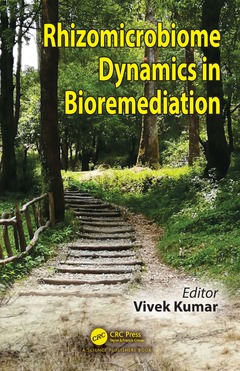Rhizomicrobiome Dynamics in Bioremediation
Coordonnateur : Kumar Vivek

Intensified agrarian and industrial activity has led to earth's soil and groundwater resources becoming polluted with hazardous materials. Bioremediation delivers a green technology using dynamics of living organisms, typically bacteria, fungi, microalgae and also plants to eliminate contaminants from ecosystem. This biological know-how is not only cost-effective compared to conventional physico-chemical approaches, but also very successful and is being employed in the field. This book focuses on important issues for several critical and common environmental pollutants, resulting in a compilation having recent updates on the bioremediation applications towards green and clean environment. This volume also describes updates on various novel approaches of bioremediation including nanotechnology, rhizomicrobiome technology, composting, metagenomics, and biosurfactants-based bioremediation. This volume is a resource for researchers, environmentalists, professionals and policy makers.
Fungal Influence on Hydrophobic Organic Pollutants Dynamics within the Soil Matrices. Bioindication and Bioremediation of Mining Degraded Soil. Nanobioremediation of Contaminated Agro-Ecosystems: Applications, Challenges and Prospects. Challenges of Multi-Omics in Improving Microbial-Assisted Phytoremediation. Microbiomes and Metallic Nanoparticles in Remediation of Contaminated Environments. Roles of Nanoparticles in Bioremediation Rate Enhancement. Biosynthesized Metal Nanoparticles in Bioremediation. Nanoparticles, Biosurfactants and Microbes in Bioremediation. Recent Updates on the Role of Biosurfactants for Remediation of Various Pollutants. Mycorrhizoremediation: A Novel Tool for Bioremediation. Agro-Ecosystem Bioremediation Mediated by Plant-Microbe Associations. Heavy Metal Contamination in Groundwater and Potential Remediation Technologies. Application of Plant-Microbe Interactions in Contaminated Agro-Ecosystem Management. Heavy Metals, Hydrocarbons, Radioactive Materials, Xenobiotics, Pesticides, Hazardous Chemicals, Explosives, Pharmaceutical Waste and Dyes Bioremediation. Bioremediation of Hydrocarbons and Classic Explosives: An Environmental Technology Removing Hazardous Wastes. Soil Bioremediation and Sustainability. Nitrogen Cycle Bacteria in Agricultural Soils: Effects of Nitrogen Fertilizers, Heavy Metals, Pesticides and Bioremediation Approaches. Bioremediation of Toxic Metals from Wastewater for Water Security. Plant-Microbe Interaction in Attenuation of the Toxic Waste in the Ecosystem. Phytoremediation of Contaminated Agro-ecosystem through Plants and Fungi. Potential of Aquatic Macrophytes in Phytoremediation of Heavy Metals: A Case Study from the Lake Sevan Basin, Armenia. Microbial Surfactants: Current Perspectives and Role in Bioremediation.
Vivek Kumar is working as Sr. Associate Professor, Himalayan School of Biosciences, Swami Rama Himalayan University, Dehradun, India and is leading the plant-microbe-interaction, bioremediation and microbial ecology research group. He is serving as editor and reviewer of several reputed international journals. He has more than hundred publications to his credit, has authored a practical manual book and edited 18 books. He also served as Microbiologist, Public Authority of Agricultural Affairs & Fish Resources, Kuwait and has been credited with first time reporting of Pink Rot inflorescence disease of Date palm in Kuwait caused by Serratia marcescens.
Date de parution : 05-2023
17.8x25.4 cm
Date de parution : 04-2021
17.8x25.4 cm
Thèmes de Rhizomicrobiome Dynamics in Bioremediation :
Mots-clés :
Biosurfactant Produced; Microbiome; Soil Contamination; Restitution; Plant Microbe Interactions; Remediation; Bioremediation Process; Environment; Endophytic Bacteria; Ecosystem; Plant Microbe Association; Plant roots; Deinococcus Radiodurans; bioremediation applications; PAHs Bioremediation; microbial-assisted phytoremediation; Mycorrhizal Fungi; rhizomicrobiome dynamics; Polluted Soils; nanobioremediation; Moisture Content; environmental pollutants; Heavy Metal Removal; Extracellular Synthesis; Crude Oil Polluted Soil; Petroleum Hydrocarbons; BCF; Pollutant Degradation; Microbial Community; Phytoremediation Process; MEUF Process; Tph; Oil Polluted Soil; PAA Hydrogel; Low Molecular Weight PAHs; High Molecular Weight PAHs



